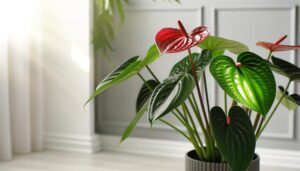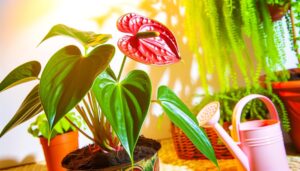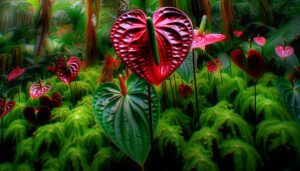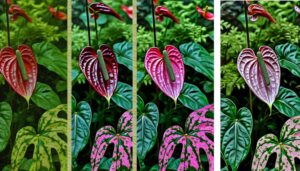Unique Traits of the Anthurium Quechua Queen: Explained!
The Anthurium Quechua Queen boasts striking heart-shaped leaves with a vibrant green hue and prominent reticulate venation. Its velvety leaf texture comes from soft trichomes, aiding in water management and tactile appeal.
You’ll notice vibrant anthocyanin-rich veins providing structural support and ornamental contrast. This plant thrives in bright indirect sunlight but adapts remarkably well to low light, optimizing chlorophyll levels.
Its exotic flowers display chromatic variability and iridescent hues, adding to its allure. Additionally, the durable spathes minimize ecological impact.
There’s much more to uncover about this fascinating plant’s unique traits and characteristics.
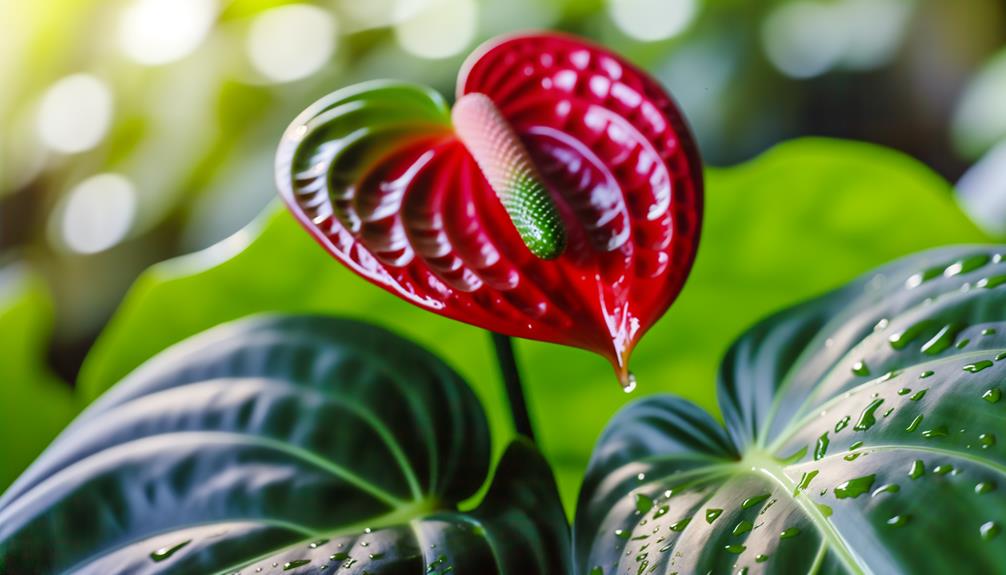
Key Takeaways
- Striking heart-shaped leaves with a vibrant green hue and prominent venation.
- Velvety leaf texture with dense trichomes for water management and tactile appeal.
- Anthocyanin-rich veins with a reddish hue for structural support and ornamental contrast.
- High adaptability to both bright indirect sunlight and low light conditions.
- Exotic flowers with chromatic variability, complex venation, and long-lasting blooms.
Striking Heart-Shaped Leaves
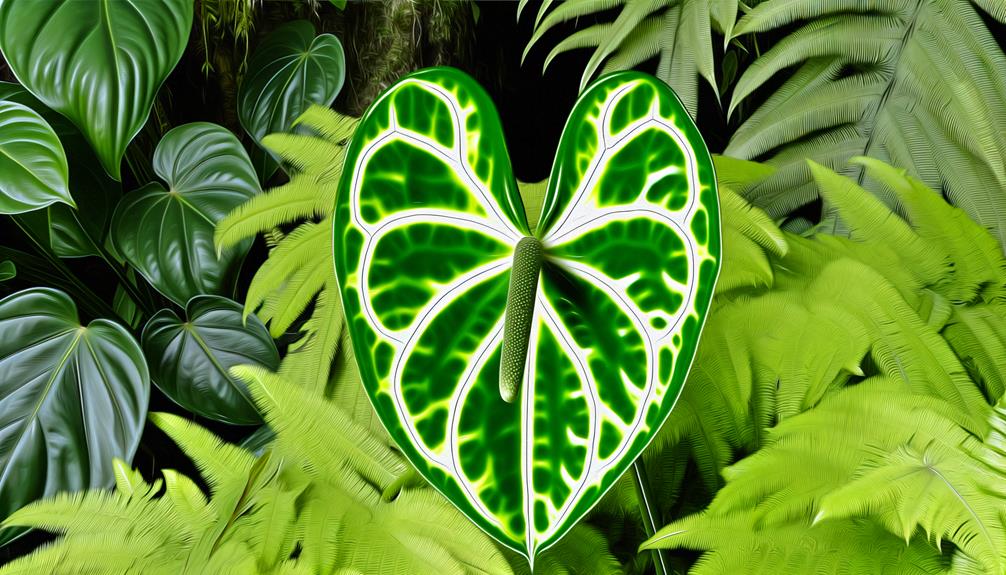
The Anthurium Quechua Queen displays striking heart-shaped leaves, scientifically known as cordate foliage, which are characterized by their vibrant green hue and prominent venation.
You’ll notice the leaves’ acuminate apex and cordate base, which provide a distinctive aesthetic appeal.
The venation is reticulate, forming a network that enhances the leaf’s structural integrity and nutrient transport. Observe the petiole, which attaches the leaf blade to the stem; it’s sturdy and supports the leaf’s substantial size.
The lamina displays an immaculate surface that’s both enchanting and functional, facilitating photosynthesis efficiently.
Each leaf measures approximately 20-25 cm in length, making it a focal point in any botanical collection.
These leaves symbolize both beauty and resilience, embodying a sense of freedom in natural form.
Velvety Leaf Texture
When you observe the Anthurium Quechua Queen, you’ll notice its velvety leaf texture, characterized by a luxurious softness and a distinctive velvet appearance.
The adaxial surface of the leaves exhibits a dense covering of trichomes, providing a tactile experience akin to fine fabric.
This unique feature not only enhances its aesthetic appeal but also plays a role in minimizing water loss through transpiration.
Luxurious Softness
Characterized by a velvety leaf texture, Anthurium Quechua Queen’s foliage displays a unique combination of soft trichomes and dense cellular structure, enhancing both tactile appeal and physiological functionality.
You’ll notice that the pubescence arises from trichomes—microscopic hair-like structures—that impart a luxurious softness when touched.
This velvety surface not only feels exquisite but also plays an essential role in reducing water loss through transpiration, optimizing the plant’s water management.
The dense cellular structure beneath these trichomes further supports mechanical integrity, ensuring the leaves remain resilient under various environmental conditions.
You’ll appreciate how this sophisticated leaf architecture blends aesthetic pleasure with practical efficiency, embodying a botanical elegance that invites both admiration and detailed study.
Distinctive Velvet Appearance
As you explore the Anthurium Quechua Queen’s luxurious softness, you’ll also notice its distinctive velvet appearance, a hallmark of its velvety leaf texture.
The adaxial (upper) surface of each leaf is covered in a dense layer of trichomes, giving it a unique, tactile sensation.
This velvety texture not only enhances its visual appeal but also provides several functional benefits:
- Moisture Retention: The trichomes help reduce water loss through transpiration.
- Light Diffusion: The velvet surface optimizes light absorption, aiding photosynthesis.
- Pest Resistance: The texture acts as a deterrent to certain herbivorous insects.
These specialized features make the Anthurium Quechua Queen an exceptional specimen, marrying aesthetic elegance with biological efficiency.
Enjoy the freedom of cultivating such a remarkable plant.
Vibrant Veins
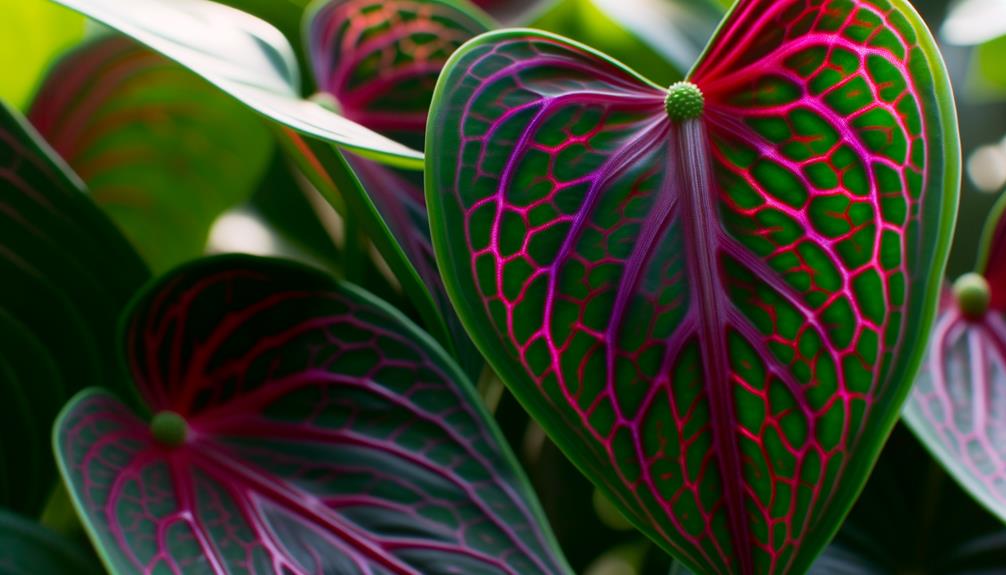
The Anthurium Quechua Queen’s vibrant patterns, prominently showcasing a network of anthocyanin-rich vascular bundles, provide both structural support and a visually striking contrast to its lush green foliage.
You’ll notice how these anthocyanins, pigmented flavonoids, imbue the patterns with a reddish hue, enhancing the plant’s ornamental appeal.
The patterns’ sturdy structure aids in efficient nutrient transport, ensuring excellent physiological function. They reinforce the lamina, preventing mechanical damage and enhancing resilience against environmental stressors.
Observe the precise arrangement of primary, secondary, and tertiary patterns, each contributing to the leaf’s overall rigidity and aesthetic.
Light Condition Tolerance
You’ll find that the Anthurium Quechua Queen thrives best under bright indirect sunlight, which optimizes its photosynthetic efficiency.
However, it also exhibits remarkable low light adaptability, maintaining foliar health and coloration even in suboptimal conditions.
Ensuring ideal light levels enhances growth, but this species’ resilience makes it versatile for various indoor environments.
Ideal Light Levels
For perfect growth, the Anthurium Quechua Queen thrives in bright, indirect light, avoiding direct sunlight which can scorch its delicate foliage.
Position your plant where it can receive filtered light, mimicking the dappled sunlight of its native rainforest habitat.
Proper light conditions impact the chlorophyll production and overall photosynthetic efficiency of the Anthurium.
To ensure best light levels, consider:
- East or North-Facing Windows: These orientations provide ample indirect light without the risk of leaf burn.
- Sheer Curtains: Using curtains can diffuse intense light, protecting the plant’s foliage from potential damage.
- Artificial Grow Lights: Full-spectrum LED grow lights can supplement natural light, particularly in dim environments.
Following these guidelines, you’ll maintain the vibrant health and lush appearance of your Anthurium Quechua Queen.
Low Light Adaptability
Despite its preference for bright, indirect light, the Anthurium Quechua Queen exhibits a notable degree of low light adaptability, allowing it to tolerate and even thrive in less-than-ideal lighting conditions.
You’ll find that its chlorophyll concentration increases, optimizing photosynthesis under diminished light. Observations indicate slower growth but sustained vitality.
| Light Condition | Adaptation Mechanism |
|---|---|
| Low Light | Enhanced chlorophyll |
| Moderate Light | Balanced growth rate |
| High Light | Potential leaf burn |
In low-light habitats, the plant’s stomatal density adapts, enhancing gas exchange efficiency. This remarkable plasticity in Anthurium andraeanum cultivars makes it an excellent choice for dimly lit interiors.
Remember, while it can endure lower light, it is crucial to monitor for signs of stress, ensuring your Anthurium Quechua Queen remains healthy and vibrant.
Bright Indirect Sunlight
In bright indirect sunlight, the Anthurium Quechua Queen maximizes its photosynthetic efficiency, utilizing its broad, glossy leaves to capture diffuse light while minimizing the risk of photodamage.
This strategic adaptation allows the plant to thrive without succumbing to the potential hazards of direct sunlight, such as chlorophyll degradation or thermal stress.
To maintain your Anthurium Quechua Queen in prime condition, consider the following:
- Place near east-facing windows for gentle morning light.
- Utilize sheer curtains to diffuse harsh rays from south or west windows.
- Rotate the plant periodically to ensure even light distribution.
Long-Lasting Spathes

Anthurium Quechua Queen’s spathes, which exhibit exceptional longevity, are a notable feature contributing to its popularity in both horticultural and botanical circles.
These spathes can last several weeks, maintaining their vibrant coloration and structural integrity.
You’ll find this trait especially valuable for ornamental purposes, as it reduces the need for frequent replacements.
| Feature | Benefit | Duration |
|---|---|---|
| Longevity | Reduced maintenance | Several weeks |
| Color retention | Aesthetic appeal | Persistent |
| Structural integrity | Less fragility | Extended period |
Their extended lifespan stems from robust cellular structure, minimizing senescence. This trait is not just an aesthetic advantage but also a practical one, reducing ecological footprint by minimizing waste. The Anthurium Quechua Queen’s spathes’ durability encapsulates both beauty and sustainability.
Exotic Flower Beauty
Possessing an unparalleled allure, the Anthurium Quechua Queen’s flowers captivate with their iridescent hues and intricate venation patterns.
You’ll find its spathes exhibiting a spectrum of colors, from deep magenta to shimmering silver. The spadix, central to its beauty, displays a dynamic range of purples and yellows.
Detailed observations reveal:
- Chromatic Variability – The flowers’ colors shift depending on light intensity and angle.
- Venation Complexity – Intricate vein patterns enhance its aesthetic appeal, offering a visual labyrinth.
- Longevity of Bloom – The flowers maintain their vibrancy for extended periods, ensuring prolonged enjoyment.
Experience the freedom of embracing such exotic elegance by adding this botanical marvel to your collection. It’s not just a plant; it’s a statement.
Conclusion
Imagine the Anthurium quechua queen in your space, its heart-shaped leaves shimmering like emerald velvet under dappled sunlight. The vibrant veins pulse with life, while long-lasting spathes add a splash of exotic allure.
This resilient beauty thrives under varied light conditions, enhancing any environment. By integrating Anthurium quechua into your collection, you’re not just adding a plant; you’re inviting a botanical marvel with unique morphological traits and enduring aesthetic appeal.

